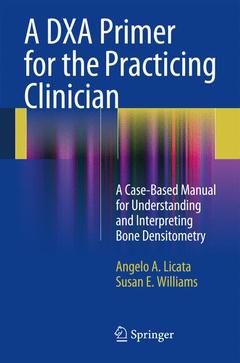Description
A DXA Primer for the Practicing Clinician, 2014
A Case-Based Manual for Understanding and Interpreting Bone Densitometry
Authors: Licata Angelo A., Williams Susan E.
Language: English
Subjects for A DXA Primer for the Practicing Clinician:
Keywords
105.49 €
In Print (Delivery period: 15 days).
Add to cart167 p. · 15.5x23.5 cm · Paperback
Description
/li>Contents
/li>Comment
/li>
Despite public perception, osteoporosis remains a widespread, devastating disease, and a very serious and costly public health threat. Early detection and treatment must be a priority for primary health care providers. Dual-energy X-ray absorptiometry (DXA) is the principal x-ray technology used to diagnose osteoporosis in its early, asymptomatic stages, to assess treatment efficacy, and to guide treatment decisions. It remains the gold standard today. A DXA Primer for the Practicing Clinician: A Case-Based Manual for Understanding and Interpreting Bone Densitometry is developed around real cases of patients? DXA measurements. The content is derived from presentations given by the authors at a national society training course and exemplifies not only the complete body of education provided through these lectures but the full range of previously undiscussed nuances as well. This practical, easy-to-read title provides the day to day problems of DXA usage that new users may encounter and that training courses do not have time to provide in detail. The central focus of the book is the presentation of what is normal and what is problematic in the use of DXA, depicting various scenarios with real case histories of patients, their corresponding DXA images and the data that explain the problems. Unique in approach and presentation, this case-based manual will be of immense value to all practitioners -- and students ? interested in providing optimal diagnosis and treatment of osteoporosis.
Introduction
- What prompted the authors to write this text
- A brief comment on the Bone & Joint Decade
- A brief word on the epidemiology of osteoporosis
- Primary disease
- Secondary disease
- That seen in chronic disease, due to Rx, men, bariatric surgery pts.
- Introduction to Densitometry
- The gold standard for non-invasive skeletal assessment
- Ultimate goal: prevent fractures
- Limitations: only a ‘snap-shot’; can not reveal what has gone on with the bones up to that point
- The many challenges of DXA
- Obtaining the images
- Interpreting the data
- Even radiologists are prone to errors
- Specific training is essential
- Clinical application to the individual patient
- Looking into the future
- New technologies
- Vision of an ‘optimal’ noninvasive, accurate, measure of bone quality
- Chief Medical Officer aboard the USS Enterprise: Lt Commander Leonard "Bones" McCoy
- Hand-held ‘tricorder’
- 3D-QCT
- Finite element analysis (FEA)
SECTION I: Fundamental Concepts
1. The History of Non-Invasive Skeletal Assessment
- Imaging Techniques
- Radiographic absorptiometry
- SPA
- DPA
- QCT
- DXA
- QUS
- PIXI
2. Common Terms and Abbreviations Defined
- Accuracy
- Apparent bone mineral density
- BMD = areal density in g/cm2 in this text
- Areal vs. volumetric
- Bone accretion
- Bone markers
- Bone Mineral Density
- Coefficient of variation
- Database
- Distal 3rd Radius
- DPA
- DXA, Central
- DXA, Peripheral
- Femoral Neck
- Femoral Shaft
- FRAX – incl application limited to untreated pts. - should not be completed by Techs; emphasize importance of clinical judgment
- Hip, Total
- LSC
- Lumbar spine (L1 – L4)
Presents what is normal and what is problematic in the use of DXA through various scenarios
Utilizes real life cases
Thoroughly explains problems and how to compensate or correct them




